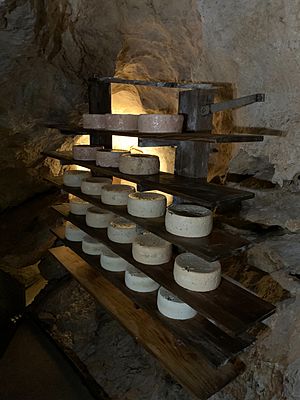Cabrales cheese facts for kids
Quick facts for kids Cabrales |
|
|---|---|
 |
|
| Country of origin | Spain |
| Region | Asturias |
| Source of milk | goat and sheep |
| Texture | Semi-hard |
Cabrales (in Spanish: queso de Cabrales) is a special type of blue cheese. It is made by farmers in the traditional way. This cheese comes from the rural areas of Asturias, Spain.
Cabrales cheese can be made from pure, fresh cow’s milk. Sometimes, goat and/or sheep milk are mixed in. This blend gives the cheese a stronger, spicier flavor. All the milk used must come from animals raised in a small area. This area is in the Picos de Europa mountains in Asturias.
Contents
How Cabrales Cheese is Made
Making Cabrales cheese starts with heating the milk. Then, a special ingredient called rennet is added. This makes the milk thicken and form curds. The liquid part, called whey, is then taken away from the curds.
The curds are pressed into round molds. These molds are called arnios. Salt is added, and the cheese is left to harden for about two weeks.
Aging in Mountain Caves
After this first step, the Cabrales cheese is moved. It ages for another two to five months in natural caves. These caves are found in the limestone mountains of the area. The cheeses are placed on wooden shelves. These shelves are known as talameras.
Workers turn and clean the cheeses regularly. The caves are very humid, usually about 90%. They are also cool, with temperatures between 7 and 13 degrees Celsius (45-55°F). These conditions are perfect for special penicillium molds to grow. These molds create the blue-green veins you see in the cheese.
Taste and Qualities
Cabrales cheese has a strong taste. It can sometimes be quite sharp or acidic. When different milks are mixed, the flavor becomes very complex. Like other famous blue cheeses such as Gorgonzola and Roquefort, Cabrales has a protected name. This means only cheese made in a certain way and place can be called Cabrales. This rule is set by European law.
When the cheese is ready, it has certain features:
- It is shaped like a cylinder. It is usually 7 to 15 cm (3-6 inches) tall. Its size and weight can vary.
- It has a soft, thin, creamy rind. The rind is gray with yellow-reddish spots.
- The inside of the cheese is smooth and firm. It does not have holes.
- At least 45% of the dry cheese is fat.
- It has at least 30% moisture.
Selling Cabrales Cheese
In the past, Cabrales cheese was sold wrapped in moist leaves. These leaves came from the Sycamore Maple tree (Acer pseudoplatanus). Today, rules say that Cabrales sold in stores must be wrapped in dark-green aluminum foil. This foil has an official stamp. This stamp shows it is a real Queso de Cabrales with a PDO (Protected Designation of Origin).
You might still find Cabrales cheese wrapped in maple leaves in the production area. However, these small batches are not approved for export. They do not have the official DO status. Other Spanish blue cheeses, like Valdeón and Picón Bejes-Tresviso, also used to be wrapped in leaves.
World Record Cheese
A large Cabrales cheese once set a world record! In August 2018, a 2.62 kg (5.78 lb) cheese from the Valfríu factory sold for €14,300 at an auction. This was a Guinness World Record at the time. In 2020, the same type of cheese broke that record. It sold for an amazing €20,500 at another auction!
In 2019, before the COVID pandemic, about 433,000 kg (over 950,000 pounds) of Cabrales cheese were made. This information comes from the Cabrales Regulatory Council.
See also
 In Spanish: Queso de Cabrales para niños
In Spanish: Queso de Cabrales para niños


